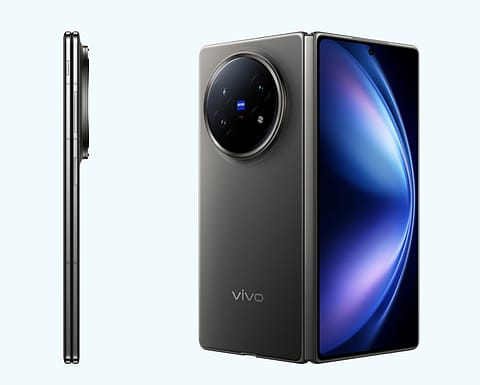Is Vivo X Fold 5 truly ready for everyday use?
Slimmer and lighter than most in its class, the Vivo X Fold 5 measures 4.3 mm when open, 9.2 mm when folded, and weighs 217 grams.

Foldables have moved far beyond their early missteps. The creaky hinges and fragile displays of the first generation are now mostly gone. Software is more refined and displays are built to last. But one issue still lingers across the category: foldables often feel heavy and thick, like carrying two phones at once.
Vivo addresses that directly. The X Fold 5 is slimmer and lighter than most phones in its class. At 4.3 mm when open, 9.2 mm when folded, and 217 grams overall, it does not feel bulky in hand or in the pocket. It is the first foldable I used that feels like it belongs in a daily routine. That confidence comes not just from its slim and light design, but also from its improved durability. With IP58, IP59 water resistance, and IP5X dust protection, the Vivo X Fold finally brings the kind of toughness foldables have long lacked.
The device is powered by the Snapdragon 8 Gen 3 processor. It skips the newer Elite variant, but the impact on real-world use is minimal. Whether running games, editing large photos, or switching between apps, the phone performs smoothly. There is some warmth around the rear camera area under heavy load, but it does not affect usability or performance. Tasks complete without lag, and the phone never feels slow.
Vivo pairs this processor with 16 GB RAM and 512 GB UFS 4.1 storage. This is enough for most users and leaves plenty of room for high-resolution photos, videos, and large apps. The haptics are crisp and tactile, adding a quiet layer of physical feedback that improves the experience.
There is also a customisable side key. You can map it to common functions like launching the camera, recording voice notes, or opening live captions. These shortcuts save time, especially when using the phone one-handed.
The software side is handled by Android 15 with Funtouch OS 15 and a new multitasking layout called Origin Workbench. It lets you run up to five apps together. One app stays in focus, while the others line up in floating windows. You can switch between them with a tap. It is helpful for reading a document while replying to messages or monitoring an email thread while watching a video. The concept works well and hints at what foldable multitasking could become.
Vivo includes several AI features as well. These tools work in the background and add value without being intrusive. There is real-time transcription for calls and meetings. Photo editing tools like AI Eraser and Reflection Remover help clean up images with a few taps. It is not about novelty. It is about quiet utility.
Recommended Stories
That said, the screens remain the strongest parts of this device. The 6.53-inch outer screen feels like using a regular high-end smartphone. Apps fit well, text is sharp, and the wider frame makes it easier to hold. When you open the phone, the 8.03-inch inner screen takes over. It feels natural, like holding a small tablet. The crease becomes nearly invisible once you start using it. Reading articles, checking spreadsheets, or watching videos on the larger display feels effortless. There is no awkward learning curve. The phone transitions from compact to expansive without friction. The brightness is strong enough to handle direct sunlight, and the colour profile is tuned to avoid oversaturation. This gives videos and photos a balanced, realistic look.
The display supports a 120 Hz refresh rate and uses LTPO technology. This keeps the motion smooth without draining the battery too quickly. Vivo also includes a Visual Enhancement mode that improves colours and contrast when watching videos in supported apps including YouTube and Netflix. The difference is subtle but visible in the right scenes.
The Zeiss co-engineered camera system is not just a collection of specs and feels refined. The 50 MP Sony IMX921 main sensor handles a wide range of conditions. It manages highlights well and avoids over-processing. Shadows stay detailed, even in harsh light. Low-light images show some softness, but the overall image still holds its tone and depth.
The 3x telephoto lens stands out. It delivers a 70 mm focal length that works well for portraits. There are also 50 mm and 85 mm modes as well, and the results feel more like a dedicated camera than a smartphone. Faces are sharp, the background blur feels natural, and colours remain consistent.
(INR CR)
The AI Scene Recogniser accurately recognises scenes, helping in capturing shots on the move. Macro shots, taken using the telephoto lens in Super Macro Mode, are accurate and detailed. You can capture texture from a distance without blur or noise. It works well for shooting surfaces like fabric, wood, or flowers without needing to get uncomfortably close.
Landscape Mode blends features like long exposure, night photography, and astro settings. It simplifies capturing complex scenes, especially for users who want better results without diving into manual settings. The camera remains one of the more versatile systems on any foldable.
Video is solid across the board. The main sensor supports 8K at 30 fps.
The phone has a 6,000 mAh battery, which is substantial for a foldable. It lasts a full day without issue, even with extended use of the inner screen. Charging is fast and efficient. The included 80-watt charger brings the phone from 20% to 80% in about 30 minutes.
The way I see it, the Vivo X Fold 5 does not try to reinvent foldables. Instead, it focuses on the things that make daily use easier. It is thinner, lighter, and more balanced. It adds smart features that quietly improve productivity. It delivers consistent camera performance and strong battery life. More importantly, it no longer feels like a compromise. It feels like a foldable ready for real life.